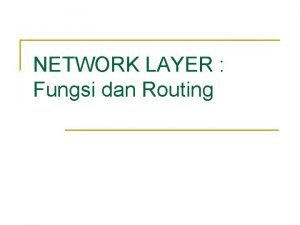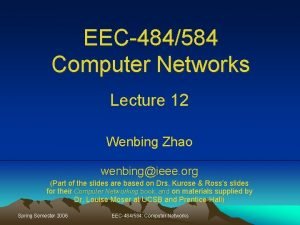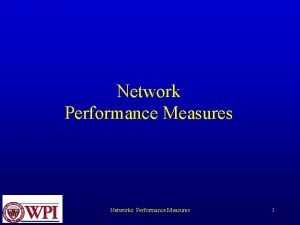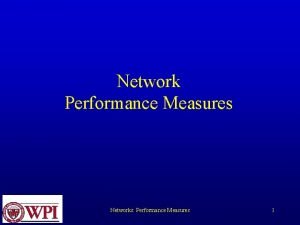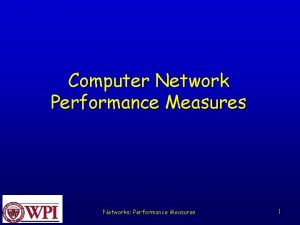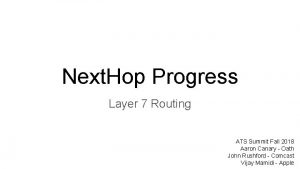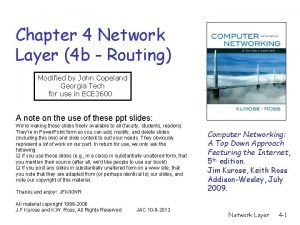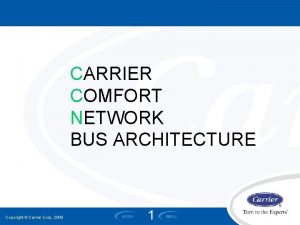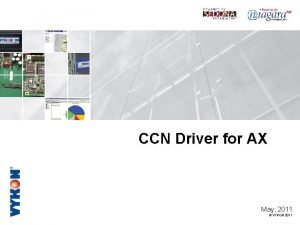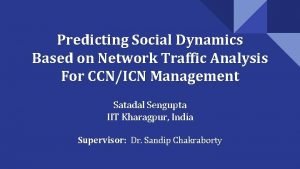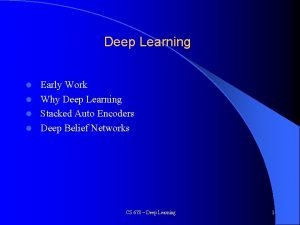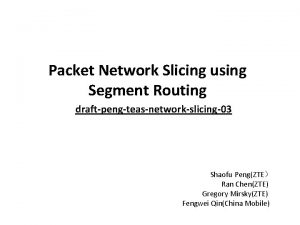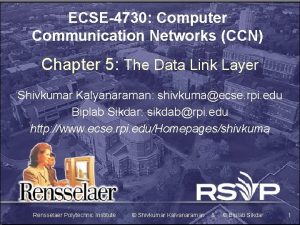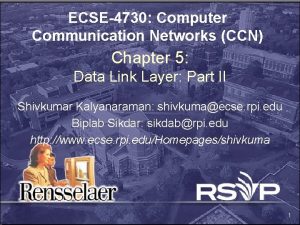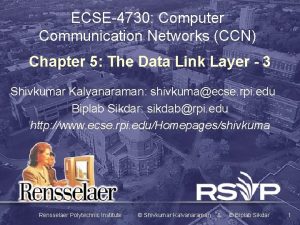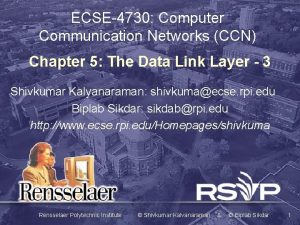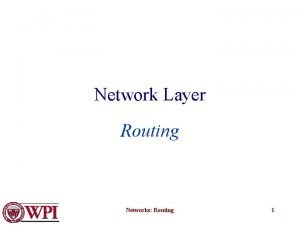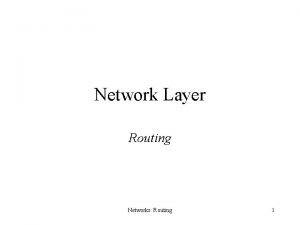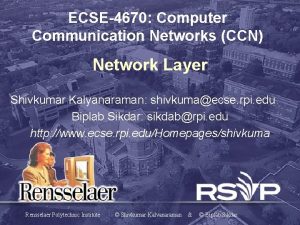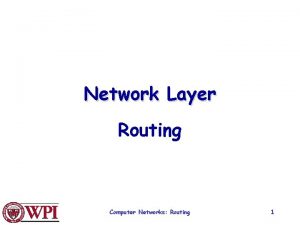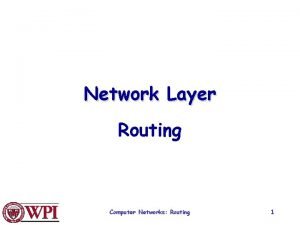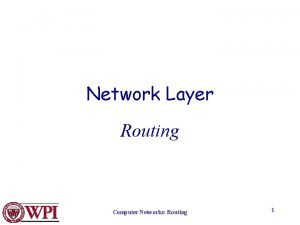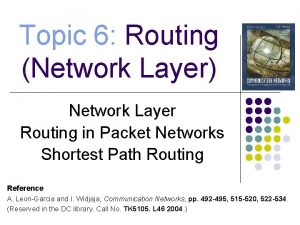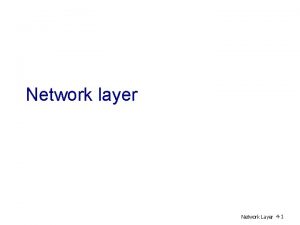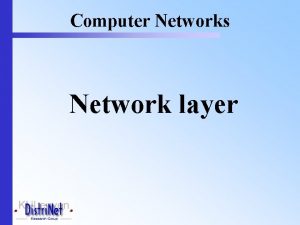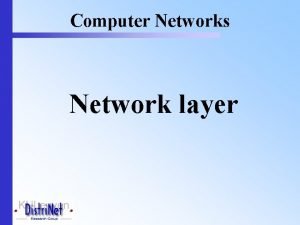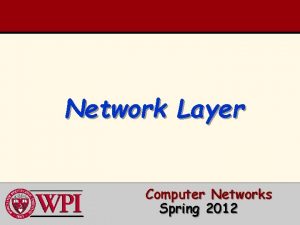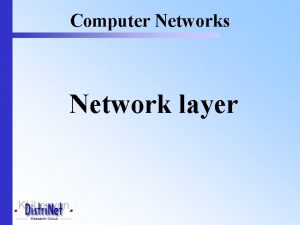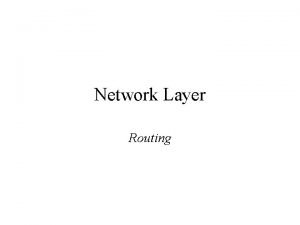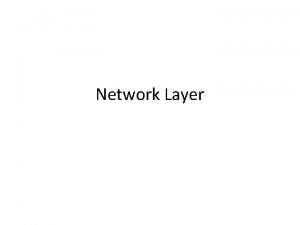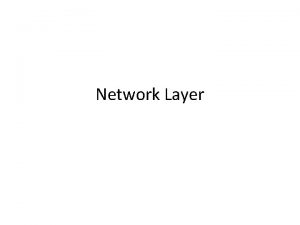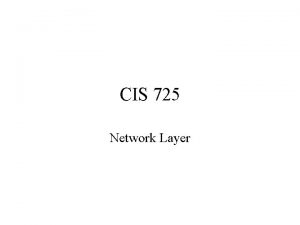ECSE4730 Computer Communication Networks CCN Network Layer Routing




































- Slides: 36

ECSE-4730: Computer Communication Networks (CCN) Network Layer (Routing) Shivkumar Kalyanaraman: shivkuma@ecse. rpi. edu Biplab Sikdar: sikdab@rpi. edu http: //www. ecse. rpi. edu/Homepages/shivkuma Rensselaer Polytechnic Institute © Shivkumar Kalvanaraman & © Biplab Sikdar

Network layer functions - 1 • transport packet from sending to receiving hosts • network layer protocols in every host, router Rensselaer Polytechnic Institute application transport network data link physical © Shivkumar Kalvanaraman network data link physical network data link physical & network data link physical © Biplab Sikdar application transport network data link physical 2

Network layer functions - 2 three important functions: • path determination: route taken by packets from source to dest. Routing algorithms • Switching (forwarding): move packets from router’s input to appropriate router output • call setup: (optional) some network architectures require router call setup along path before data flows Rensselaer Polytechnic Institute © Shivkumar Kalvanaraman & © Biplab Sikdar 3

Network service model service abstraction Q: What service model for “channel” transporting packets from sender to receiver? • guaranteed bandwidth? • preservation of inter-packet timing (no jitter)? • loss-free delivery? • in-order delivery? • congestion feedback to sender? Rensselaer Polytechnic Institute © Shivkumar Kalvanaraman & The most important abstraction provided by network layer: ? ? ? virtual circuit or datagram? © Biplab Sikdar 4

Datagram networks: the Internet model - 1 • no call setup at network layer • routers: no state about end-to-end connections – no network-level concept of “connection” • packets typically routed using destination host ID – packets between same source-dest pair may take different paths Rensselaer Polytechnic Institute © Shivkumar Kalvanaraman & © Biplab Sikdar 5

Datagram networks: the Internet model - 2 application transport network data link 1. Send data physical Rensselaer Polytechnic Institute application transport 2. Receive data network data link physical © Shivkumar Kalvanaraman & © Biplab Sikdar 6

Routing protocol Goal: determine “good” path (sequence of routers) thru network from source to dest. • Graph abstraction for routing algorithms: • graph nodes are routers • graph edges are physical links 5 2 A 2 1 D 3 C F 1 3 1 5 E 2 “good” path: • link cost: delay, $ cost, or congestion level Rensselaer Polytechnic Institute B © Shivkumar Kalvanaraman typically means minimum cost path other def’s possible & © Biplab Sikdar 7

Routing Algorithm classification - 1 Global or decentralized information? Global: • all routers have complete topology, link cost info • “link state” algorithms Decentralized: • router knows physically-connected neighbors, link costs to neighbors • iterative process of computation, exchange of partial info with neighbors • “distance vector” algorithms Rensselaer Polytechnic Institute © Shivkumar Kalvanaraman & © Biplab Sikdar 8

Routing Algorithm classification - 2 Static or dynamic? Static: • routes change slowly over time Dynamic: • routes change more quickly – periodic update – in response to link cost changes Rensselaer Polytechnic Institute © Shivkumar Kalvanaraman & © Biplab Sikdar 9

A Link-State Routing Algorithm - 1 Dijkstra’s algorithm • net topology, link costs known to all nodes – accomplished via “link state broadcast” – all nodes have same info • computes least cost paths from one node (‘source”) to all other nodes – gives routing table for that node – iterative: after k iterations, know least cost path to k dest. ’s Rensselaer Polytechnic Institute © Shivkumar Kalvanaraman & © Biplab Sikdar 10

A Link-State Routing Algorithm - 2 Notation: • c(i, j): link cost from node i to j. cost infinite if not direct neighbors • D(v): current value of cost of path from source to dest. V • p(v): predecessor node (neighbor of v) along path from source to v • N: set of nodes whose least cost path definitively known Rensselaer Polytechnic Institute © Shivkumar Kalvanaraman & © Biplab Sikdar 11

Dijkstra’s algorithm: example Step 0 1 2 3 4 5 start N A AD ADEBCF D(B), p(B) D(C), p(C) D(D), p(D) D(E), p(E) D(F), p(F) 2, A 1, A 5, A infinity 2, A 4, D 2, D infinity 2, A 3, E 4, E 5 A 2 2 1 Rensselaer Polytechnic Institute B D 3 C 3 1 5 F 1 E 2 © Shivkumar Kalvanaraman & © Biplab Sikdar

Dijsktra’s Algorithm 1 Initialization: 2 N = {A} 3 for all nodes v 4 if v adjacent to A 5 then D(v) = c(A, v) 6 else D(v) = infty 7 8 Loop 9 find w not in N such that D(w) is a minimum 10 add w to N 11 update D(v) for all v adjacent to w and not in N: 12 D(v) = min( D(v), D(w) + c(w, v) ) 13 /* new cost to v is either old cost to v or known 14 shortest path cost to w plus cost from w to v */ 15 until all nodes in N Rensselaer Polytechnic Institute © Shivkumar Kalvanaraman & © Biplab Sikdar

Dijkstra’s algorithm: discussion Algorithm complexity: n nodes • each iteration: need to check all nodes, w, not in N • n*(n+1)/2 comparisons: O(n**2) • more efficient implementations possible: O(nlogn) Oscillations possible: • e. g. , link cost = amount of carried traffic Rensselaer Polytechnic Institute © Shivkumar Kalvanaraman & © Biplab Sikdar 14

Distance Vector Routing Algorithm - 1 iterative: • continues until no nodes exchange info. • self-terminating: no “signal” to stop asynchronous: • nodes need not exchange info/iterate in lock step! distributed: • each node communicates only with directlyattached neighbors Rensselaer Polytechnic Institute © Shivkumar Kalvanaraman & © Biplab Sikdar 15

Distance Vector Routing Algorithm - 2 Distance Table data structure • each node has its own • row for each possible destination • column for each directly-attached neighbor to node • example: in node X, for dest. Y via neighbor Z: distance from X to = X Y, via Z as next hop D (Y, Z) Z{D (Y, w)} = c(X, Z) + min w Rensselaer Polytechnic Institute © Shivkumar Kalvanaraman & © Biplab Sikdar 16

Distance table: example A E D (C, D) D (A, D) E C E D () A B D A 1 14 5 B 7 8 5 C 6 9 4 D 4 11 2 2 8 1 E B cost to destination via E 2 D D = c(E, D) + minw {D (C, w)} = 2+2 = 4 D = c(E, D) + minw {D (A, w)} = 2+3 = 5 loop! destination 7 1 B D (A, B) = c(E, B) + minw {D (A, w)} = 8+6 = 14 Rensselaer Polytechnic Institute loop! © Shivkumar Kalvanaraman & © Biplab Sikdar

Distance table gives routing table cost to destination via E Outgoing link to use, cost B D A 1 14 5 A A, 1 B 7 8 5 B D, 5 C 6 9 4 C D, 4 D 4 11 2 D D, 4 Distance table Rensselaer Polytechnic Institute destination A destination D () Routing table © Shivkumar Kalvanaraman & © Biplab Sikdar

Distance Vector Routing: overview - 1 Iterative, asynchronous: each local iteration caused by: • local link cost change • message from neighbor: its least cost path change from neighbor Distributed: • each node notifies neighbors only when its least cost path to any destination changes – neighbors then notify their neighbors if necessary Rensselaer Polytechnic Institute © Shivkumar Kalvanaraman & © Biplab Sikdar 19

Distance Vector Routing: overview - 2 Each node: wait for (change in local link cost of msg from neighbor) recompute distance table if least cost path to any dest has changed, notify neighbors Rensselaer Polytechnic Institute © Shivkumar Kalvanaraman & © Biplab Sikdar 20

Distance Vector Algorithm - 1 At all nodes, X: 1 Initialization: 2 for all adjacent nodes v: X 3 D (*, v) = infty 4 D (v, v) = c(X, v) X /* the * operator means "for all rows" */ 5 for all destinations, y 6 send min. X D (y, w) to each neighbor /* w over all X's neighbors */ w Rensselaer Polytechnic Institute © Shivkumar Kalvanaraman & © Biplab Sikdar

Distance Vector Algorithm - 2 8 loop 9 wait (until I see a link cost change to neighbor V 10 or until I receive update from neighbor V) 11 12 if (c(X, V) changes by d) 13 /* change cost to all dest's via neighbor v by d */ 14 /* note: d could be positive or negative */ X 15 for all destinations y: DX (y, V) = D (y, V) + d 16 17 else if (update received from V wrt destination Y) 18 /* shortest path from V to some Y has changed */ 19 /* V has sent a new value for its min DV(Y, w) */ w 20 /* call this received new value is "newval" */ X 21 for the single destination y: D (Y, V) = c(X, V) + newval 22 X 23 if we have a new minw D (Y, w)for any destination Y 24 send new value of min DX (Y, w) to all neighbors w 25 26 forever Rensselaer Polytechnic Institute © Shivkumar Kalvanaraman & © Biplab Sikdar

Distance Vector Algorithm: example - 1 X 2 Y 7 1 Z Z X D (Y, Z) = c(X, Z) + minw {D (Y, w)} = 7+1 = 8 Y X D (Z, Y) = c(X, Y) + minw {D (Z, w)} = 2+1 = 3 Rensselaer Polytechnic Institute © Shivkumar Kalvanaraman & © Biplab Sikdar

Distance Vector: link cost changes - 1 Link cost changes: 1 node detects local link cost change updates distance table (line 15) if cost change in least cost path, notify neighbors (lines 23, 24) 4 X Y 1 50 Z algorithm terminates “good news travels fast” Rensselaer Polytechnic Institute © Shivkumar Kalvanaraman & © Biplab Sikdar

Distance Vector: link cost changes - 2 Link cost changes: 60 good news travels fast bad news travels slow - “count to infinity” problem! 4 X Y 1 50 Z algorithm continues on! Rensselaer Polytechnic Institute © Shivkumar Kalvanaraman & © Biplab Sikdar

Distance Vector: poisoned reverse If Z routes through Y to get to X : 60 Z tells Y its (Z’s) distance to X is infinite (so Y won’t route to X via Z) will this completely solve count to infinity problem? 4 X Y 50 1 Z algorithm terminates Rensselaer Polytechnic Institute © Shivkumar Kalvanaraman & © Biplab Sikdar

Comparison of LS and DV algorithms - 1 Message complexity • LS: with n nodes, E links, O(n. E) msgs sent each • DV: exchange between neighbors only – convergence time varies Speed of Convergence • LS: O(n**2) algorithm requires O(n. E) msgs – may have oscillations • DV: convergence time varies – may be routing loops – count-to-infinity problem Rensselaer Polytechnic Institute © Shivkumar Kalvanaraman & © Biplab Sikdar 27

Comparison of LS and DV algorithms - 1 Robustness: what happens if router malfunctions? LS: – node can advertise incorrect link cost – each node computes only its own table DV: – DV node can advertise incorrect path cost – each node’s table used by others • error propagate thru network Rensselaer Polytechnic Institute © Shivkumar Kalvanaraman & © Biplab Sikdar 28

Internet AS Hierarchy Intra-AS border (exterior gateway) routers Inter-AS interior (gateway) routers Rensselaer Polytechnic Institute © Shivkumar Kalvanaraman & © Biplab Sikdar 29

Intra-AS Routing • Also known as Interior Gateway Protocols (IGP) • Most common IGPs: – RIP: Routing Information Protocol – OSPF: Open Shortest Path First – IGRP: Interior Gateway Routing Protocol (Cisco propr. ) Rensselaer Polytechnic Institute © Shivkumar Kalvanaraman & © Biplab Sikdar 30

RIP (Routing Information Protocol) - 1 • Distance vector algorithm • Included in BSD-UNIX Distribution in 1982 • Distance metric: # of hops (max = 15 hops) • Distance vectors: exchanged every 30 sec via Response Message (also called advertisement) • Each advertisement: route to up to 25 destination nets Rensselaer Polytechnic Institute © Shivkumar Kalvanaraman & © Biplab Sikdar 31

RIP (Routing Information Protocol) - 2 z w A x D y B C Destination Network Next Router Num. of hops to dest. w y z x A B B -- 2 2 7 1 …. . . Routing table in D Rensselaer Polytechnic Institute © Shivkumar Kalvanaraman & © Biplab Sikdar 32

RIP: Link Failure and Recovery If no advertisement heard after 180 sec --> neighbor/link declared dead – routes via neighbor invalidated – new advertisements sent to neighbors – neighbors in turn send out new advertisements (if tables changed) – link failure info quickly propagates to entire net – poison reverse used to prevent ping-pong loops (infinite distance = 16 hops) Rensselaer Polytechnic Institute © Shivkumar Kalvanaraman & © Biplab Sikdar 33

RIP Table processing - 1 • RIP routing tables managed by application -level process called route-d (daemon) • advertisements sent in UDP packets, periodically repeated Rensselaer Polytechnic Institute © Shivkumar Kalvanaraman & © Biplab Sikdar 34

RIP Table processing - 2 Router: giroflee. eurocom. fr Destination ----------127. 0. 0. 1 192. 168. 2. 193. 55. 114. 192. 168. 3. 224. 0. 0. 0 default Gateway Flags Ref Use Interface ---------- --------127. 0. 0. 1 UH 0 26492 lo 0 192. 168. 2. 5 U 2 13 fa 0 193. 55. 114. 6 U 3 58503 le 0 192. 168. 3. 5 U 2 25 qaa 0 193. 55. 114. 6 U 3 0 le 0 193. 55. 114. 129 UG 0 143454 Three attached class C networks (LANs) Router only knows routes to attached LANs Default router used to “go up” Route multicast address: 224. 0. 0. 0 Loopback interface (for debugging) Rensselaer Polytechnic Institute © Shivkumar Kalvanaraman & © Biplab Sikdar 35

OSPF (Open Shortest Path First) • “open”: publicly available • Uses Link State algorithm – LS packet dissemination – Topology map at each node – Route computation using Dijkstra’s algorithm • OSPF advertisement carries one entry per neighbor router • Advertisements disseminated to entire AS (via flooding) Rensselaer Polytechnic Institute © Shivkumar Kalvanaraman & © Biplab Sikdar 36
 The network layer concerns with
The network layer concerns with Network layer design issues in computer networks
Network layer design issues in computer networks Fungsi layer network
Fungsi layer network Routing algorithms in computer networks
Routing algorithms in computer networks Broadcast routing in computer networks
Broadcast routing in computer networks Datagram network and virtual circuit network
Datagram network and virtual circuit network Backbone networks in computer networks
Backbone networks in computer networks Switching in data link layer
Switching in data link layer Osi reference model ppt
Osi reference model ppt Data link layer design issues in computer networks
Data link layer design issues in computer networks Data link layer in hdlc in computer networks
Data link layer in hdlc in computer networks Vertical line in html
Vertical line in html Mark tinka
Mark tinka Hydrologic routing and hydraulic routing
Hydrologic routing and hydraulic routing Power routing in vlsi
Power routing in vlsi Principles of network applications in computer networks
Principles of network applications in computer networks Network performance measurement in computer networks
Network performance measurement in computer networks Network performance measurement
Network performance measurement Network performance measurement in computer networks
Network performance measurement in computer networks Inter vlan routing layer 3 switch
Inter vlan routing layer 3 switch Layer 7 routing
Layer 7 routing Layer 4 routing
Layer 4 routing Po box 202117 florence
Po box 202117 florence Carrier comfort network
Carrier comfort network Informe ines
Informe ines Capitale circolante netto positivo
Capitale circolante netto positivo Ccn driver
Ccn driver Edamis web portal
Edamis web portal Icn ccn
Icn ccn A link layer protocol for quantum networks
A link layer protocol for quantum networks Greedy layer wise training of deep networks
Greedy layer wise training of deep networks Types of network topology
Types of network topology Network slicing with segment routing
Network slicing with segment routing Pigmented layer and neural layer
Pigmented layer and neural layer Path of food from mouth to anus
Path of food from mouth to anus Secure socket layer and transport layer security
Secure socket layer and transport layer security Layer 6 presentation layer
Layer 6 presentation layer


